The function of cellular respiration is to __________.
- reduce CO2
- produce carbohydrates
- extract usable energy from glucose
- extract CO2 from the atmosphere
- synthesize macromolecules from monomers
extract usable energy from glucose
Ex.
The function of cellular respiration is to extract usable energy from glucose.
The most prevalent and efficient catabolic pathway is cellular respiration, in which oxygen is consumed as a reactant, along with the organic fuel (frequently glucose). In cellular respiration, the same reaction occurs in stages: An electron transport chain breaks the “fall” of electrons in this reaction into a series of smaller steps and stores some of the released energy in a form that can be used to make ATP. (The rest of the energy is released as heat.)
The summary equation for cellular respiration is:
C6H12O6 + 6 O2 6 → CO2 + 6 H2O + Energy.
The fuel (glucose) is oxidized and oxygen is reduced. The electrons lose potential energy along the way, and energy is released. In general, organic molecules that have an abundance of hydrogen are excellent fuels because their bonds are a source of “hilltop” electrons, whose energy may be released as these electrons “fall” down an energy gradient when they are transferred to oxygen.
The summary equation for respiration indicates that hydrogen is transferred from glucose to oxygen. But the important point, not visible in the summary equation, is that the energy state of the electron changes as hydrogen (with its electron) is transferred to oxygen. In respiration, the oxidation of glucose transfers electrons to a lower energy state, liberating energy that becomes available for ATP synthesis.
In the overall process of glycolysis and cellular respiration, __________ is oxidized and __________ is reduced.
- glucose; oxygen
- ATP; oxygen
- oxygen; ATP
- glucose; ATP
- carbon dioxide; water
glucose; oxygen
Ex.
In the overall process of glycolysis and cellular respiration, glucose is oxidized and oxygen is reduced.
In cellular respiration, electrons and hydrogen are removed from glucose and added to oxygen. During aerobic respiration, glucose (C6H12O6) is oxidized to CO2, and O2 is reduced to H2O. Electrons lose potential energy during their transfer from glucose or other organic compounds to oxygen. The energy-yielding redox process of greatest interest to biologists is respiration, which involves the oxidation of glucose and other molecules in food. The summary equation for cellular respiration can be considered a redox process:
C6H12O6 + 6 O2 → 6 CO2 + 6 H2O + Energy.
A molecule becomes more oxidized when it __________.
- gains an electron
- loses a (H+) ion
- gains a hydrogen
- changes shape
- loses a hydrogen
- loses an electron
loses an electron
Ex.
A molecule becomes more oxidized when it loses an electron.
During oxidation, an electron is removed. In many chemical reactions, there is a transfer of one or more electrons (e-) from one reactant to another. These electron transfers are called oxidation-reduction reactions, or redox reactions for short. In a redox reaction, the loss of electrons from one substance is called oxidation, and the addition of electrons to another substance is known as reduction. (Note that adding electrons is called reduction; negatively charged electrons added to an atom reduce the amount of positive charge of that atom.)
The electron donor is called the reducing agent, which provides the donated electron. The electron acceptor is the oxidizing agent by removing an electron. Because an electron transfer requires both a donor and an acceptor, oxidation and reduction always go together.
Which of the following metabolic pathways produce(s) the most ATP, per glucose molecule metabolized, during cellular respiration?
- Citric acid cycle
- The electron transport chain and oxidative phosphorylation
- Fermentation
- Glycolysis
- Substrate-level phosphorylation
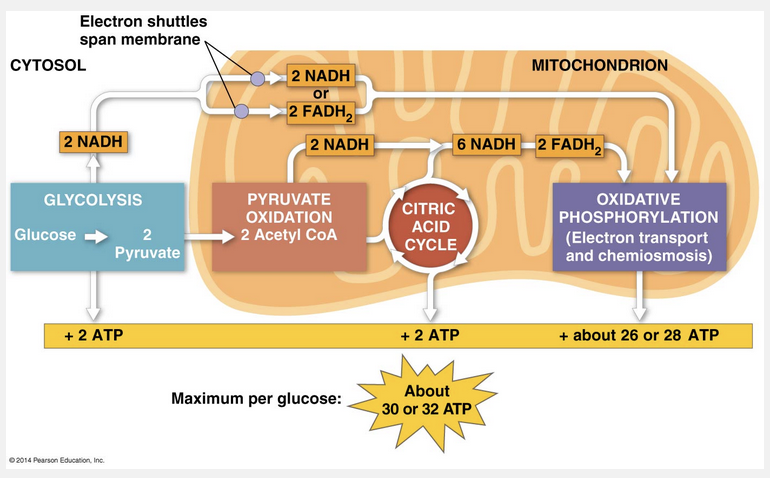
The electron transport chain and oxidative phosphorylation
Ex.
The electron transport chain and oxidative phosphorylation produce the most ATP.
During respiration, most energy flows in this sequence: glucose to NADH to electron transport chain to proton-motive force to ATP. We can do some bookkeeping to calculate the ATP profit when cellular respiration oxidizes a molecule of glucose to six molecules of carbon dioxide. The three main processes of this metabolic enterprise are glycolysis, pyruvate oxidation and the citric acid cycle, and the electron transport chain, which drives oxidative phosphorylation. Substrate-level phosphorylation, what occurs in glycolysis and the citric acid cycle, produces a total of four ATP. Since most of the energy from the electrons in glucose ends up in NADH and FADH2, the electron transport chain and, specifically, chemiosmosis produce the most ATP, approximately 28 ATP per molecule of glucose that is metabolized during cellular respiration.
Glycolysis produces a net of two ATP.
Fermentation, via glycolysis, produces two ATP.
Substrate-level phosphorylation, which includes glycolysis and the citric acid cycle, produces four ATP.
The citric acid cycle produces two ATP.
What is the role of oxygen in the electron transport chain?
- It is oxidized with carbon to form CO2.
- It is reduced to form water.
- Oxygen has no role in the electron transport chain.
- It is oxidized to form ADP.
- It is reduced to form CO2.
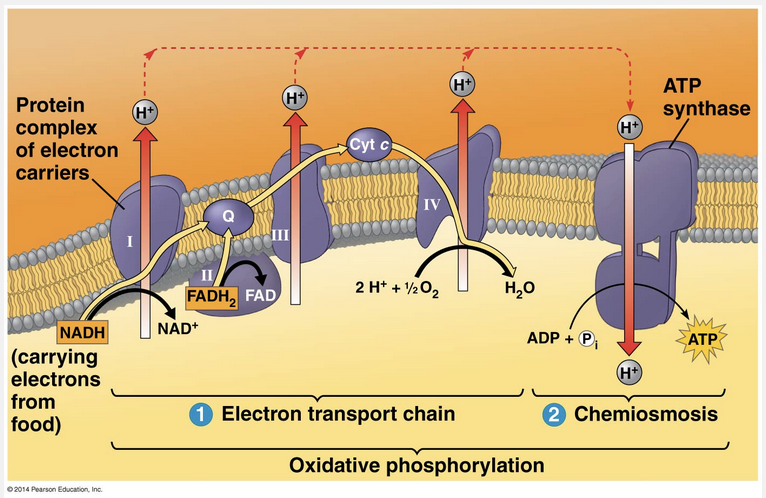
It is reduced to form water.
Ex.
It is reduced to form water.
Oxygen acts as a terminal electron acceptor in the electron transport chain. Once the electrons from NADH and FADH2 have passed down the chain, they have completed their function. These electrons must be accounted for rather than released into the mitochondrion. Along with H+, oxygen is reduced by the electrons to form water, a by-product of the electron transport chain.
Oxygen cannot be oxidized. It is an oxidizing agent.
Oxygen is reduced to form water, not carbon dioxide.
ADP is the oxidized form of ATP. Oxygen cannot be oxidized to form ADP.
Oxygen is the terminal electron acceptor in the electron transport chain.
Most of the electrons removed from glucose by cellular respiration are used for which of the following processes?
- Producing a proton gradient for ATP synthesis in the mitochondria
- Producing a proton gradient for ATP synthesis in the mitochondria AND driving substrate-level phosphorylation in glycolysis
- Reducing NAD+ to NADH in glycolysis and the citric acid cycle
- Reducing NAD+ to NADH in glycolysis and the citric acid cycle AND producing a proton gradient for ATP synthesis in the mitochondria.
- Driving substrate-level phosphorylation in glycolysis
Reducing NAD+ to NADH in glycolysis and the citric acid cycle AND producing a proton gradient for ATP synthesis in the mitochondria.
Ex.
Most of the electrons removed from glucose by cellular respiration are used for reducing NAD+ to NADH in glycolysis and the citric acid cycle AND producing a proton gradient for ATP synthesis in the mitochondria.
The full name for NAD+, nicotinamide adenine dinucleotide, describes its structure: The molecule consists of two nucleotides joined together at their phosphate groups. (Nicotinamide is a nitrogenous base, although not one that is present in DNA or RNA.) The enzymatic transfer of 2 electrons and 1 proton (H+) from an organic molecule in food to NAD+ reduces the NAD+ to NADH; the second proton (H+) is released. Most of the electrons removed from food are transferred initially to NAD+. Glucose and other organic fuels are broken down in a series of steps, each one catalyzed by an enzyme. At key steps, electrons are stripped from the glucose. Each electron travels with a proton—thus, as a hydrogen atom. The hydrogen atoms are not transferred directly to oxygen, but instead are usually passed first to an electron carrier, a coenzyme called NAD+. NAD+ is well suited as an electron carrier because it can cycle easily between oxidized (NAD+) and reduced (NADH) states. As an electron acceptor, NAD+ functions as an oxidizing agent during respiration.
Which part of the catabolism of glucose by cellular respiration requires molecular oxygen (O2) and produces CO2?
- The combination of glycolysis and the citric acid cycle
- The citric acid cycle
- The electron transport chain
- The combination of the citric acid cycle and electron transport
- Glycolysis
The combination of the citric acid cycle and electron transport
Ex.
The combination of the citric acid cycle and electron transport are part of the catabolism of glucose by cellular respiration that require molecular oxygen (O2) and produces CO2.
CO2 is produced in the citric acid cycle, and O2 is taken up in electron transport. In eukaryotes, pyruvate enters the mitochondrion and is oxidized to a compound called acetyl CoA, which enters the citric acid cycle. There, the breakdown of glucose to carbon dioxide is completed. (In prokaryotes, these processes take place in the cytosol.) Thus, the carbon dioxide produced by respiration represents fragments of oxidized organic molecules.
Muscle tissues make lactate from pyruvate to do which of the following?
- regenerate NAD+
- speed up the rate of glycolysis
- utilize the energy in pyruvate
- produce additional CO2
- get rid of pyruvate produced by glycolysis
regenerate NAD+
Ex.
Muscle tissues make lactate from pyruvate to regenerate NAD+.
Human muscle cells make ATP by lactic acid fermentation when oxygen is scarce. This allows them to regenerate NAD+ so that glycolysis can continue. On the cellular level, our muscle cells behave as facultative anaerobes. In such cells, pyruvate is a fork in the metabolic road that leads to two alternative catabolic routes. Under aerobic conditions, pyruvate can be converted to acetyl CoA, and oxidation continues in the citric acid cycle via aerobic respiration. Under anaerobic conditions, lactic acid fermentation occurs: Pyruvate is diverted from the citric acid cycle, serving instead as an electron acceptor to recycle NAD+. To make the same amount of ATP, a facultative anaerobe has to consume sugar at a much faster rate when fermenting than when respiring.
Which of the following pairs of pathways and their location in the cell is incorrectly matched?
- Electron transport chain: mitochondrion
- All of the responses are correctly matched.
- Oxidative phosphorylation: mitochondrion
- Citric acid cycle: cytosol
- Glycolysis: cytosol
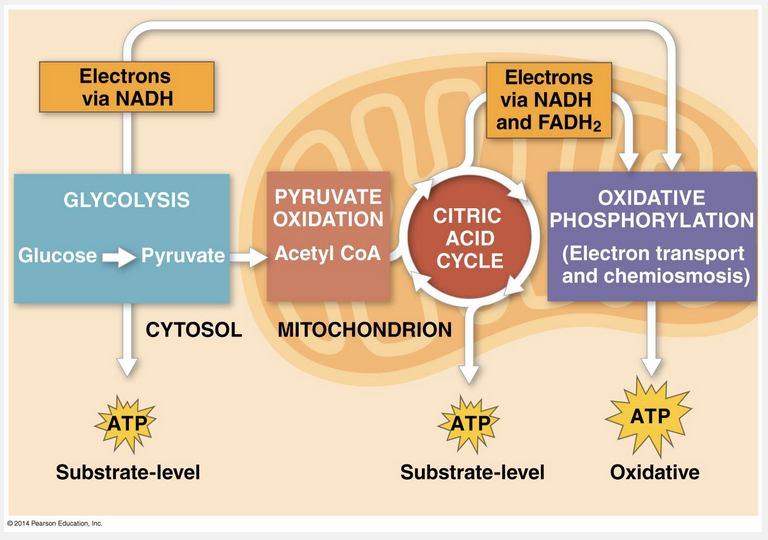
Citric acid cycle: cytosol
Ex.
The following pair of a pathway and its location in the cell is incorrectly matched: citric acid cycle: cytosol.
The citric acid cycle does not occur in the cytosol. The citric acid cycle functions as a metabolic furnace that oxidizes organic fuel derived from pyruvate. Pyruvate is broken down to three CO2 molecules, including the molecule of CO2 released during the conversion of pyruvate to acetyl CoA. The cycle generates one ATP per turn by substrate-level phosphorylation, but most of the chemical energy is transferred to NAD+ and a related electron carrier, the coenzyme FAD (flavin adenine dinucleotide, which is derived from riboflavin, a B vitamin), during the redox reactions. The total yield per glucose from the citric acid cycle is six NADH molecules, two FADH2 molecules, and the equivalent of two ATP molecules. This pathway occurs in the matrix of the mitochondrion.
Glycolysis occurs in the cytosol.
The electron transport chain occurs on the cristae of the mitochondrion.
Oxidative phosphorylation occurs in the mitochondrion.
Which statement correctly describes the difference between alcohol fermentation and lactic acid fermentation?
- None of the listed responses is correct.
- Only lactic acid fermentation produces NAD+ to facilitate the production of ATP in glycolysis.
- Lactic acid fermentation produces lactate, and alcohol fermentation produces ethanol.
- Alcohol fermentation produces lactate, and lactic acid fermentation produces ethanol.
- Alcohol fermentation is an aerobic pathway, and lactic acid fermentation is an anaerobic pathway.
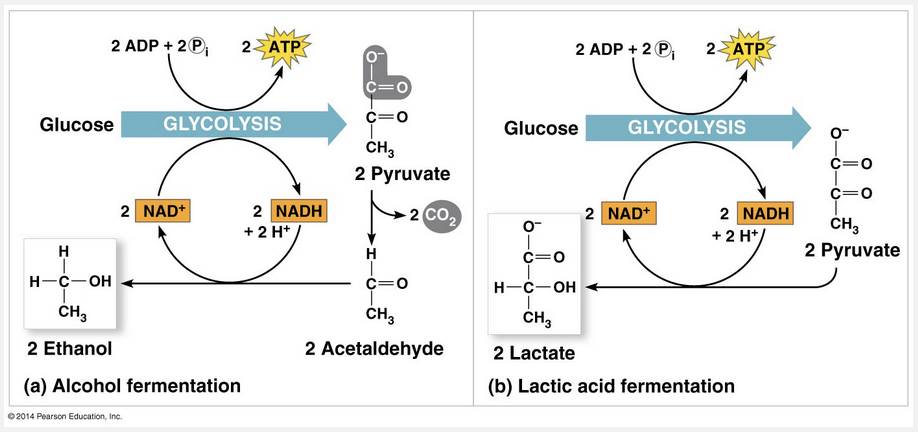
Lactic acid fermentation produces lactate, and alcohol fermentation produces ethanol.
Ex.
Lactic acid fermentation produces lactate, and alcohol fermentation produces ethanol.
Fermentation consists of glycolysis plus reactions that regenerate NAD+ by transferring electrons from NADH to pyruvate or derivatives of pyruvate. The NAD+ can then be reused to oxidize sugar by glycolysis, which nets two molecules of ATP by substrate-level phosphorylation. There are many types of fermentation, and they differ in the end products formed from pyruvate. Two types commonly harnessed by humans for food and industrial production are alcohol fermentation and lactic acid fermentation. In alcohol fermentation, pyruvate is converted to ethanol (ethyl alcohol) in two steps. The first step releases carbon dioxide from the pyruvate, which is converted to the two-carbon compound acetaldehyde. In the second step, acetaldehyde is reduced by NADH to ethanol. This regenerates the supply of NAD+ needed for the continuation of glycolysis. During lactic acid fermentation, pyruvate is reduced directly by NADH to form lactate as an end product, with no release of CO2.
Alcohol fermentation produces ethanol, and lactic acid fermentation produces lactate.
Both alcohol fermentation and lactic acid fermentation produce NAD+, which keeps glycolysis going.
Both fermentation pathways are anaerobic.
Most of the ATP in cellular respiration is produced by the process of chemiosmosis. How does this process produce ATP?
- Electrons from NADH and FADH2 are used to add a phosphate to ADP.
- Through substrate-level phosphorylation
- Pyruvate is oxidized, providing energy to add a phosphate to ADP.
- H+ flows across the inner mitochondrial membrane through the enzyme ATP synthase.
- Phosphates are stripped from phosphorylated sugars during the energy payoff phase.
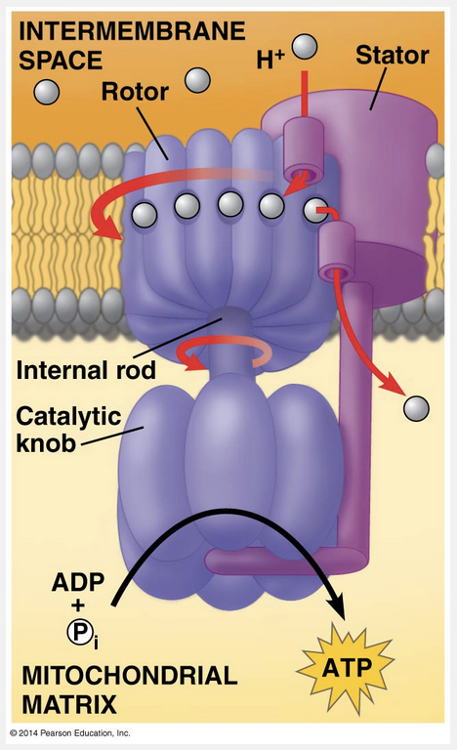
H+ flows across the inner mitochondrial membrane through the enzyme ATP synthase.
Ex.
H+ flows across the inner mitochondrial membrane through the enzyme ATP synthase.
Populating the inner membrane of the mitochondrion or the prokaryotic plasma membrane are many copies of a protein complex called ATP synthase, the enzyme that makes ATP from ADP and inorganic phosphate. ATP synthase works like an ion pump running in reverse. Ion pumps usually use ATP as an energy source to transport ions against their gradients. Rather than hydrolyzing ATP to pump protons against their concentration gradient, ATP synthase, under the conditions of cellular respiration, uses the energy of an existing ion gradient to power ATP synthesis. The power source for ATP synthase is the difference in the concentration of H+ on opposite sides of the inner mitochondrial membrane. This process, in which energy stored in the form of a hydrogen ion gradient across a membrane is used to drive cellular work such as the synthesis of ATP, is called chemiosmosis.
ATP is produced when phosphates are stripped from phosphorylated sugars during the energy payoff phase of glycolysis.
ATP is produced by the oxidation of pyruvate during the citric acid cycle.
Substrate-level phosphorylation occurs during glycolysis, the citric acid cycle, and fermentation.
Electrons from NADH and FADH2 are used to drive the electron transport chain.
Most of the NADH that delivers electrons to the electron transport chain comes from which of the following processes?
- Substrate-level phosphorylation
- Anabolic pathways
- Glycolysis
- Oxidative phosphorylation
- The citric acid cycle
The citric acid cycle
Ex.
Most of the NADH that delivers electrons to the electron transport chain comes from the citric acid cycle.
Both NADH and FADH2 are produced during the citric acid cycle. The citric acid cycle functions as a metabolic furnace that oxidizes organic fuel derived from pyruvate. The cycle generates 1 ATP per turn by substrate-level.
During aerobic respiration, molecular oxygen (O2) is used for which of the following purposes?
- As a source of O2 in every reaction that produces CO2
- At the end of glycolysis to oxidize pyruvate
- Between glycolysis and the citric acid cycle to split a carbon from pyruvate, producing CO2
- At the end of the citric acid cycle to regenerate citric acid
- At the end of the electron transport chain to accept electrons and form H2O
At the end of the electron transport chain to accept electrons and form H2O
Ex.
During aerobic respiration, molecular oxygen (O2) is used at the end of the electron transport chain to accept electrons and form H2O.
In aerobic respiration, the final electron acceptor is oxygen but in anaerobic respiration, the final acceptor is another molecule that is electronegative (although invariably less so than oxygen). Passage of electrons from NADH to the electron transport chain not only regenerates the NAD+ required for glycolysis but pays an ATP bonus when the stepwise electron transport from this NADH to oxygen drives oxidative phosphorylation. An even bigger ATP payoff comes from the oxidation of pyruvate in the mitochondrion, which is unique to respiration. Without an electron transport chain, the energy still stored in pyruvate is unavailable to most cells.
Which metabolic pathway is common to both fermentation and cellular respiration of a glucose molecule?
- Synthesis of acetyl CoA from pyruvate
- Reduction of pyruvate to lactate
- The citric acid cycle
- Glycolysis
- The electron transport chain
Glycolysis
Ex.
Glycolysis is a metabolic pathway common to both fermentation and cellular respiration of a glucose molecule.
Fermentation consists of glycolysis plus reactions that regenerate NAD+ by transferring electrons from NADH to pyruvate or derivatives of pyruvate. The NAD+ can then be reused to oxidize sugar by glycolysis, which nets two molecules of ATP by substrate-level phosphorylation.
There are many types of fermentation, differing in the end products formed from pyruvate. Two common types are alcohol fermentation and lactic acid fermentation. Fermentation and anaerobic or aerobic respiration all use glycolysis to oxidize glucose, but they differ in their final electron acceptor and whether an electron transport chain is used (respiration) or not (fermentation). Respiration yields more ATP because aerobic respiration, with O2 as the final electron acceptor, yields about 16 times as much ATP as does fermentation.
Which of the following is a correct description of the events of cellular respiration and the sequence of events in cellular respiration?
- Glycolysis; reduction of pyruvate; TCA cycle; oxidative phosphorylation
- Glycolysis; oxidative phosphorylation; TCA cycle; oxidation of pyruvate
- Oxidation of glucose to pyruvate; reduction of pyruvate; TCA cycle; oxidative phosphorylation
- Oxidation of glucose to pyruvate; oxidation of pyruvate; oxidation of acetyl-coA; oxidative phosphorylation
- Oxidation of pyruvate; TCA cycle; oxidation of glucose to pyruvate; oxidative phosphorylation
Oxidation of glucose to pyruvate; oxidation of pyruvate; oxidation of acetyl-coA; oxidative phosphorylation
Ex.
The following is a correct description of the events of cellular respiration and the sequence of events in cellular respiration: oxidation of glucose to pyruvate; oxidation of pyruvate; oxidation of acetyl-coA; oxidative phosphorylation.
Aerobic respiration occurs in three stages: (1) glycolysis, (2) pyruvate oxidation and the citric acid cycle, and (3) oxidative phosphorylation (electron transport and chemiosmosis). In glycolysis, glucose, a six-carbon sugar, is split into two three-carbon sugars. These smaller sugars are then oxidized and their remaining atoms rearranged to form two molecules of pyruvate. If molecular oxygen is present, the pyruvate enters a mitochondrion (in eukaryotic cells) via active transport and it is first converted to a compound called acetyl coenzyme A, or acetyl CoA, which is further oxidized to CO2 in the citric acid cycle. NADH and a similar electron carrier, a coenzyme called FADH2, transfer electrons derived from glucose to electron transport chains, which are built into the inner mitochondrial membrane. (In prokaryotes, the electron transport chains are located in the plasma membrane.) During oxidative phosphorylation, electron transport chains convert the chemical energy to a form used for ATP synthesis in the process called chemiosmosis.
In which process is glucose oxidized to form two molecules of pyruvate?
- Electron transport chain
- Chemiosmosis
- Glycolysis
- Citric acid cycle
- Fermentation
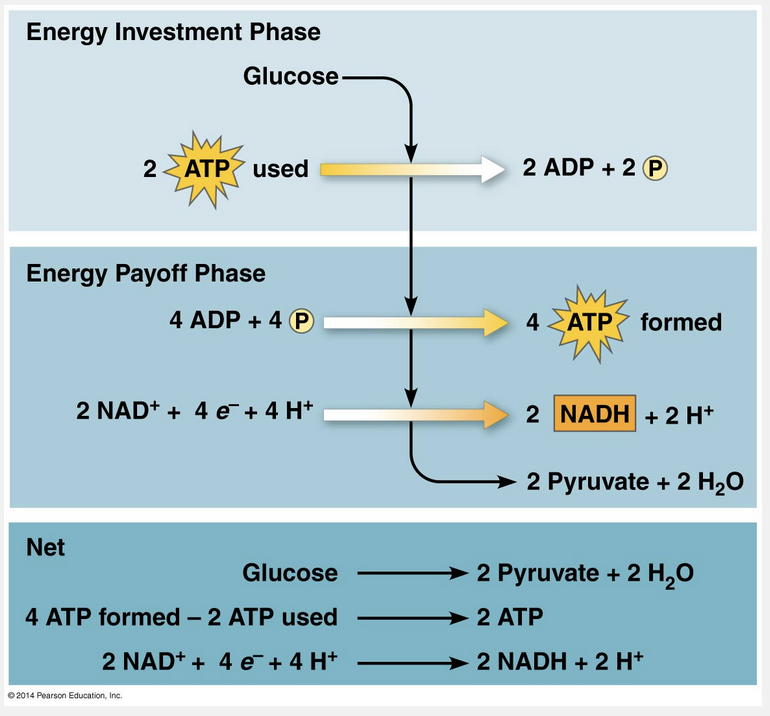
Glycolysis
Ex.
Glycolysis is the process during which glucose is oxidized to form two molecules of pyruvate. The word glycolysis means “sugar splitting,” and that is exactly what happens during this pathway. Glucose, a six-carbon sugar, is split into two three-carbon sugars. These smaller sugars are then oxidized and their remaining atoms rearranged to form two molecules of pyruvate.
The citric acid cycle completes the breakdown of glucose by oxidizing the carbons in pyruvate.
Fermentation processes pyruvate in order to keep glycolysis going.
The electron transport chain oxidizes NADH and FADH2, not glucose.
Chemiosmosis is the process in which energy stored in the form of a hydrogen ion gradient across a membrane is used to drive cellular work such as the synthesis of ATP.
After completion of the citric acid cycle, most of the usable energy from the original glucose molecule is in the form of __________.
- FADH2
- ATP
- NADH
- acetyl CoA
- CO2
NADH
Ex.
After completion of the citric acid cycle, most of the usable energy from the original glucose molecule is in the form of NADH.
The citric acid cycle produces three NADH per turn of the cycle. Now let’s tally the energy-rich molecules produced by the citric acid cycle. For each acetyl group entering the cycle, 3 NAD+ are reduced to NADH. However, in one step electrons are transferred not to NAD+, but to FAD, which accepts 2 electrons and 2 protons to become FADH2.
In preparing pyruvate to enter the citric acid cycle, which of the following steps occurs?
- Pyruvate is oxidized and decarboxylated, and the resulting electrons are donated to NADH to produce NAD+.
- Pyruvate is reduced and decarboxylated, and the resulting electrons oxidize an NAD+ to an NADH.
- Pyruvate is ionized directly to acetyl-coA.
- Pyruvate is reduced to acetyl-coA, which involves the reduction of pyruvate, the addition of a carbon dioxide from the environment, and its reduction by NADH.
- Pyruvate is oxidized and decarboxylated, and the removed electrons are used to reduce an NAD+ to an NADH.
Pyruvate is oxidized and decarboxylated, and the removed electrons are used to reduce an NAD+ to an NADH.
Ex.
In preparing pyruvate to enter the citric acid cycle, pyruvate is oxidized and decarboxylated, and the removed electrons are used to reduce an NAD+ to an NADH.
The step linking glycolysis and the citric acid cycle is carried out by a multienzyme complex that catalyzes three reactions: Pyruvate’s carboxyl group (–COO-), which is already fully oxidized and thus has little chemical energy, is removed and given off as a molecule of CO2. (This is the first step in which CO2 is released during respiration.) The remaining two-carbon fragment is oxidized, forming acetate (CH3COO-, the ionized form of acetic acid). The extracted electrons are transferred to NAD+, storing energy in the form of NADH.
Finally, coenzyme A (CoA), a sulfur-containing compound derived from a B vitamin, is attached via its sulfur atom to the acetate, forming acetyl CoA, which has a high potential energy; in other words, the reaction of acetyl CoA to yield lower-energy products is highly exergonic. This molecule will now feed its acetyl group into the citric acid cycle for further oxidation.
A small amount of ATP is made in glycolysis by which of the following processes?
- Attachment of a free inorganic phosphate (Pi) group to ADP to make ATP
- Transport of electrons through a series of carriers
- Harnessing energy from the sun
- Transfer of electrons and hydrogen atoms to NAD+
- Transfer of a phosphate group from a fragment of glucose to ADP by substrate-level phosphorylation
Transfer of a phosphate group from a fragment of glucose to ADP by substrate-level phosphorylation
Ex.
A small amount of ATP is made in glycolysis by the transfer of a phosphate group from a fragment of glucose to ADP by substrate-level phosphorylation.
Glucose is phosphorylated at the beginning of glycolysis. Glycolysis oxidizes glucose to two molecules of pyruvate. The oxidizing agent of glycolysis is NAD+, and neither oxygen nor any electron transfer chain is involved. Overall, glycolysis is exergonic, and some of the energy made available is used to produce 2 ATP (net) by substrate-level phosphorylation. If oxygen is present, then additional ATP is made by oxidative phosphorylation when NADH passes electrons removed from glucose to the electron transport chain. But glycolysis generates 2 ATP whether oxygen is present or not—that is, whether conditions are aerobic or anaerobic. Oxidative phosphorylation accounts for almost 90% of the ATP generated by respiration with a smaller amount formed directly in a few reactions of glycolysis.
Fermentation by itself produces no ATP but keeps glycolysis going, which produces a small amount of ATP. How does fermentation do this?
- Fermentation produces NADH, which fuels the electron transport chain and facilitates chemiosmosis.
- Fermentation oxidizes the carbons in pyruvate to CO2, which is then used in glycolysis.
- Fermentation produces lactate, which keeps glycolysis going.
- Fermentation oxidizes NADH to NAD+, which facilitates the production of ATP in glycolysis.
- Fermentation reduces NAD+ to NADH, which facilitates the production of ATP in glycolysis.
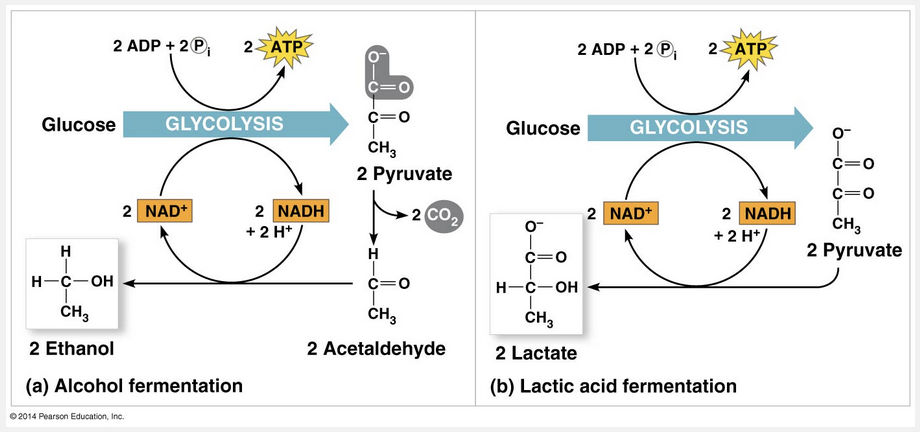
Fermentation oxidizes NADH to NAD+, which facilitates the production of ATP in glycolysis.
Ex.
Fermentation oxidizes NADH to NAD+, which facilitates the production of ATP in glycolysis.
Fermentation is a way of harvesting chemical energy without using either oxygen or any electron transport chain—in other words, without cellular respiration. As an alternative to respiratory oxidation of organic nutrients, fermentation is an extension of glycolysis that allows continuous generation of ATP by the substrate-level phosphorylation of glycolysis. For this to occur, there must be a sufficient supply of NAD+ to accept electrons during the oxidation step of glycolysis. Fermentation consists of glycolysis plus reactions that regenerate NAD+ by transferring electrons from NADH to pyruvate or derivatives of pyruvate. The NAD+ can then be reused to oxidize sugar by glycolysis, which nets two molecules of ATP by substrate-level phosphorylation.
Fermentation oxidizes NADH to NAD+ to keep glycolysis going.
Fermentation does oxidize some of the carbons from pyruvate into CO2, but CO2 is not a reactant for glycolysis.
Fermentation produces NAD+ and does not provide any reactants to the electron transport chain.
One type of fermentation produces lactate, but lactate is not a reactant for glycolysis.
All of the processes involved in cellular respiration produce ATP. Which of the following processes produces the most ATP?
- Citric acid cycle
- Glycolysis
- Substrate-level phosphorylation
- Fermentation
- Oxidative phosphorylation

Oxidative phosphorylation
Ex.
Oxidative phosphorylation produces the most ATP.
The harvesting of energy from glucose by cellular respiration is a cumulative function of three metabolic stages. Glycolysis, which occurs in the cytosol, begins the degradation process by breaking down glucose into two molecules of a compound called pyruvate. In eukaryotes, pyruvate enters the mitochondrion and is oxidized to a compound called acetyl CoA, which enters the citric acid cycle. There, the breakdown of glucose to carbon dioxide is completed. Some of the steps of glycolysis and the citric acid cycle are redox reactions in which dehydrogenases transfer electrons from substrates to NAD+, forming NADH. In the third stage of respiration, the electron transport chain accepts electrons (most often via NADH) from the breakdown products of the first two stages and passes these electrons from one molecule to another. At the end of the chain, the electrons are combined with molecular oxygen and hydrogen ions (H+), forming water. The energy released at each step of the chain is stored in a form that the mitochondrion (or prokaryotic cell) can use to make ATP from ADP. This mode of ATP synthesis is called oxidative phosphorylation because it is powered by the redox reactions of the electron transport chain. This process produces far more ATP than the other two processes combined.
Glycolysis produces only two net ATP.
The citric acid cycle produces only two net ATP.
Substrate-level phosphorylation includes both glycolysis and the citric acid cycle and produces only four net ATP.
Fermentation is not part of cellular respiration.
Glucose is the primary fuel for cellular respiration. Which of the following molecules can also be used by cellular respiration to generate ATP?
- Fatty acids
- All of the listed responses are correct.
- Glycerol
- Amino acids
- None of the listed responses is correct.
All of the listed responses are correct.
Ex.
Amino acids, glycerol, and fatty acids can all be used in cellular respiration.
Free glucose molecules are not common in the diets of humans and other animals. We obtain most of our calories in the forms of fats, proteins, sucrose and other disaccharides, and starch, a polysaccharide. All these organic molecules in food can be used by cellular respiration to make ATP.
Proteins can also be used for fuel, but first they must be digested to their constituent amino acids. Catabolism can also harvest energy stored in fats obtained either from food or from storage cells in the body. After fats are digested to glycerol and fatty acids, the glycerol is converted to glyceraldehyde 3-phosphate, an intermediate of glycolysis. Most of the energy of a fat is stored in the fatty acids.
The energy from the electrons in NADH and FADH2 fuel what process in the electron transport chain?
- The movement of H+ through ATP synthase
- The electrons in NADH and FADH2 are not involved in the electron transport chain.
- The pumping of H+ across the cristae of the mitochondrion
- Chemiosmosis
- The oxidation of oxygen

The pumping of H+ across the cristae of the mitochondrion
Ex.
The energy from the electrons in NADH and FADH2 fuels the pumping of H+ across the cristae of the mitochondrion.
The electron transport chain is a collection of molecules embedded in the inner membrane of the mitochondrion in eukaryotic cells. Most components of the chain are proteins, which exist in multiprotein complexes numbered I through IV. Electrons acquired from glucose by NAD+ during glycolysis and the citric acid cycle are transferred from NADH to the first molecule of the electron transport chain in complex I. As the electrons are passed from one molecule to the next, energy from them is used by the molecule to actively transport H+ into the intermembrane space of the mitochondrion. This creates an H+ gradient that represents potential energy that will be used to synthesize ATP in chemiosmosis.
The movement of H+ through ATP synthase produces ATP.
Chemiosmosis is the process in which energy stored in the form of a hydrogen ion gradient across a membrane is used to drive cellular work such as the synthesis of ATP.
Oxygen is never oxidized in the electron transport chain. It is reduced to water.
The electrons in NADH and FADH2 are the primary energy source for the electron transport chain.
What is the total production of ATP, NADH, and FADH2 in the citric acid cycle from one molecule of glucose?
- Four ATP only
- The citric acid cycle does not produce any of these molecules.
- 32 ATP only
- Two ATP, six NADH, and two FADH2
- One ATP, three NADH, and one FADH2
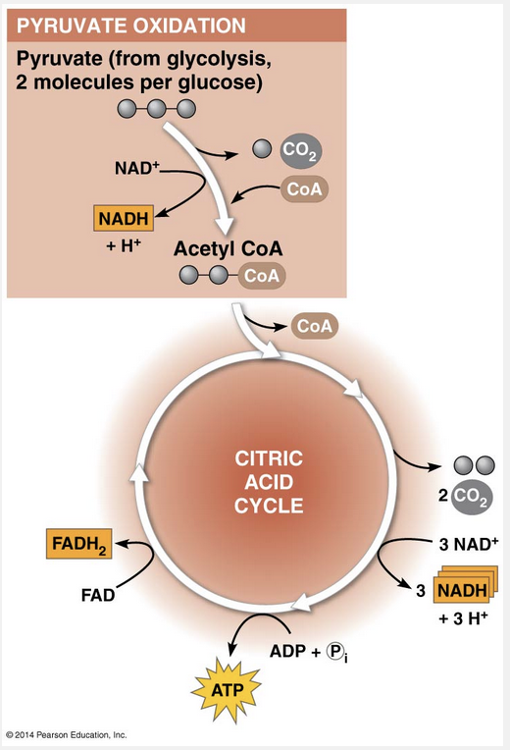
Two ATP, six NADH, and two FADH2
Ex.
The citric acid cycle produces two ATP, six NADH, and two FADH2.
The citric acid cycle functions as a metabolic furnace that oxidizes organic fuel derived from pyruvate. Pyruvate is broken down to three CO2 molecules, including the molecule of CO2 released during the conversion of pyruvate to acetyl CoA. The cycle generates one ATP per turn by substrate-level phosphorylation, but most of the chemical energy is transferred to NAD+ and a related electron carrier, the coenzyme FAD (flavin adenine dinucleotide, which is derived from riboflavin, a B vitamin), during the redox reactions. The total yield per glucose from the citric acid cycle is six NADH molecules, two FADH2 molecules, and the equivalent of two ATP molecules.
The ATP synthase in a human cell obtains energy for synthesizing ATP directly from which of the following processes?
- The movement of electrons through a series of carriers
- The oxidation of glucose
- The flow of H+ across the inner mitochondrial membrane through the ATP synthase enzyme
- The reduction of oxygen
- The oxidation of NADH and FADH2
The flow of H+ across the inner mitochondrial membrane through the ATP synthase enzyme
Ex.
The ATP synthase in a human cell obtains energy for synthesizing ATP directly from the flow of H+ across the inner mitochondrial membrane through the ATP synthase enzyme.
Hydrogen ions flow along an electrochemical gradient across the inner mitochondrial membrane. The gradient is the source of the energy for ATP production. Populating the inner membrane of the mitochondrion or the prokaryotic plasma membrane are many copies of a protein complex called ATP synthase, the enzyme that actually makes ATP from ADP and inorganic phosphate. ATP synthase works like an ion pump running in reverse. Ion pumps usually use ATP as an energy source to transport ions against their gradients. Enzymes can catalyze a reaction in either direction, depending on the ΔG for the reaction, which is affected by the local concentrations of reactants and products.
Rather than hydrolyzing ATP to pump protons against their concentration gradient, under the conditions of cellular respiration ATP synthase uses the energy of an existing ion gradient to power ATP synthesis. The power source for the ATP synthase is a difference in the concentration of H+ on opposite sides of the inner mitochondrial membrane. (We can also think of this gradient as a difference in pH, since pH is a measure of H+ concentration.) This process, in which energy stored in the form of a hydrogen ion gradient across a membrane is used to drive cellular work such as the synthesis of ATP, is called chemiosmosis.
Fermentation is essentially glycolysis plus an extra step in which pyruvate is reduced to form lactate or alcohol and carbon dioxide. This last step __________.
- removes poisonous oxygen from the environment
- enables the cell to recycle the reduced NADH to oxidized NAD+
- enables the cell to make pyruvate into substances it can use
- prevents pyruvate from accumulating
- extracts a bit more energy from glucose
enables the cell to recycle the reduced NADH to oxidized NAD+
Ex.
Fermentation is essentially glycolysis plus an extra step in which pyruvate is reduced to form lactate or alcohol and carbon dioxide. This last step enables the cell to recycle the reduced NADH to oxidized NAD+.
Normally, the reduced NADH delivers its electrons to the electron transport chain, enabling NAD+ to be recycled to glycolysis. As an alternative to respiratory oxidation of organic nutrients, fermentation is an extension of glycolysis that allows continuous generation of ATP by the substrate-level phosphorylation of glycolysis. For this to occur, there must be a sufficient supply of NAD+ to accept electrons during the oxidation step of glycolysis. Without some mechanism to recycle NAD+ from NADH, glycolysis would soon deplete the cell’s pool of NAD+ by reducing it all to NADH and would shut itself down for lack of an oxidizing agent. Under aerobic conditions, NAD+ is recycled from NADH by the transfer of electrons to the electron transport chain. An anaerobic alternative is to transfer electrons from NADH to pyruvate, the end product of glycolysis.
During the energy payoff phase of glycolysis, __________.
- ATP is produced
- glucose is phosphorylated before it is split into two three-carbon molecules
- glucose is phosphorylated after it is split into two three-carbon molecules
- NADH is produced
- NADH and ATP are produced

NADH and ATP are produced
Ex.
During the energy payoff phase of glycolysis, both NADH and ATP are produced.
The word glycolysis means “sugar splitting,” and that is exactly what happens during this pathway. Glucose, a six-carbon sugar, is split into two three-carbon sugars. These smaller sugars are then oxidized and their remaining atoms rearranged to form two molecules of pyruvate. (Pyruvate is the ionized form of pyruvic acid.) Glycolysis can be divided into two phases: the energy investment phase and the energy payoff phase. During the energy investment phase, the cell actually “spends” ATP by phosphorylating glucose. Glucose is then split into two three-carbon molecules. The investment is repaid with interest during the energy payoff phase, when ATP is produced by substrate-level phosphorylation and NAD+ is reduced to NADH by the release of electrons during the oxidation of glucose. The net energy yield from glycolysis, per glucose molecule, is two ATP plus two NADH.
Glucose is phosphorylated during the energy investment phase of glycolysis. Glucose is not phosphorylated during the energy payoff phase of glycolysis.
In what molecule(s) is the majority of the chemical energy from pyruvate transferred during the citric acid cycle?
- Oxygen and carbon dioxide
- NADH and FADH2
- ADP
- ATP
- Glucose

NADH and FADH2
Ex.
Most of the chemical energy from pyruvate is transferred to NADH and FADH2.
The citric acid cycle functions as a metabolic furnace that oxidizes organic fuel derived from pyruvate. Pyruvate is broken down to three CO2 molecules, including the molecule of CO2 released during the conversion of pyruvate to acetyl CoA. The cycle generates one ATP per turn by substrate-level phosphorylation, but most of the chemical energy is transferred to NAD+ and a related electron carrier, the coenzyme FAD (flavin adenine dinucleotide, which is derived from riboflavin, a B vitamin), during the redox reactions. The total yield per glucose from the citric acid cycle is six NADH molecules, two FADH2 molecules, and the equivalent of two ATP molecules.
Some of the chemical energy from pyruvate is transferred to ATP, but more of it is transferred to NADH and FADH2.
ADP is the hydrolyzed form of ATP and has had most of its chemical energy taken away.
Glucose contains chemical energy, but it is the source of energy for cellular respiration.
Oxygen and carbon dioxide are not energy carriers and do not get energy transferred to them.
During the energy investment phase of glycolysis, __________.
- glucose is phosphorylated after it is split into two three-carbon molecules
- ATP is produced
- carbon dioxide is produced
- glucose is phosphorylated before it is split into two three-carbon molecules
- NADH is produced

glucose is phosphorylated before it is split into two three-carbon molecules
Ex.
During the energy investment phase of glycolysis, glucose is phosphorylated before it is split into two three-carbon molecules.
The word glycolysis means “sugar splitting,” and that is exactly what happens during this pathway. Glucose, a six-carbon sugar, is split into two three-carbon sugars. These smaller sugars are then oxidized and their remaining atoms rearranged to form two molecules of pyruvate. (Pyruvate is the ionized form of pyruvic acid.) Glycolysis can be divided into two phases: the energy investment phase and the energy payoff phase. During the energy investment phase, the cell actually “spends” ATP by phosphorylating glucose. Glucose is then split into two three-carbon molecules. The investment is repaid with interest during the energy payoff phase, when ATP is produced by substrate-level phosphorylation and NAD+ is reduced to NADH by the release of electrons during the oxidation of glucose. The net energy yield from glycolysis, per glucose molecule, is two ATP plus two NADH.
Glucose is phosphorylated before it is split into two three-carbon molecules.
NADH is produced in the energy payoff phase of glycolysis.
ATP is produced in the energy payoff phase of glycolysis.
Glycolysis does not produce carbon dioxide.
Cells must regulate their metabolic pathways so that they do not waste resources. What is the most common mechanism that regulates cellular respiration in most cells?
- Feedback inhibition of glycolysis
- Slowing down ATP production from oxidative phosphorylation
- Slowing down ATP production from fermentation
- Positive feedback
- Denaturing of the enzymes in glycolysis
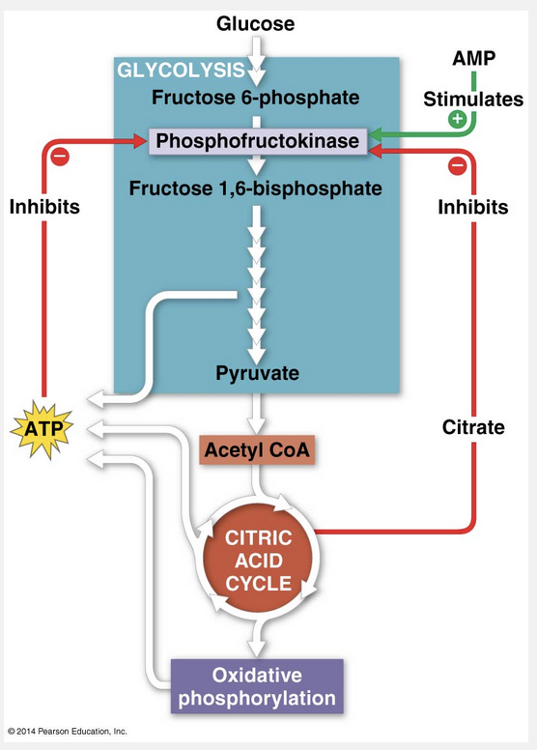
Feedback inhibition of glycolysis
Ex.
Cells regulate cellular respiration through feedback inhibition of glycolysis.
Basic principles of supply and demand regulate the metabolic economy. A cell does not waste energy making more of a particular substance than it needs. The most common mechanism for this regulation is feedback inhibition. If the cell is working hard and its ATP concentration begins to drop, respiration speeds up. When there is plenty of ATP to meet demand, respiration slows down, sparing valuable organic molecules for other functions. Control is based mainly on regulating the activity of enzymes at strategic points in the catabolic pathway. One important switch is phosphofructokinase, the enzyme that catalyzes step 3 of glycolysis. This is the first step that commits the substrate irreversibly to the glycolytic pathway. By controlling the rate of this step, the cell can speed up or slow down the entire catabolic process.
Positive feedback results in an increase of the output of a process rather than slows it down.
Denaturing the enzymes in glycolysis would not be an efficient way to control cellular respiration since the cell would have to continue to produce new enzymes each time the pathway was active.
Oxidative phosphorylation is not the pathway that is controlled by feedback inhibition.
Fermentation is not part of cellular respiration.